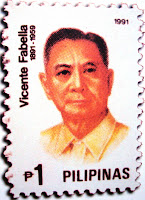Leandro H. Fernandez on Stamps

Fernandez earned his masters degree in History and Doctorate in Education from the University of Chicago in 1912. In 1935, he became the Dean of the College of Liberal Arts at the University of the Philippines and Chairman of the Graduate Studies Program. He wrote A Brief History of the Philippines which was issued as a textbook for history students.
A foremost educator and noted historian, Leandro C. Fernandez rose to national prominence from his humble beginnings through hard work, perseverance, and consistency motivated by a strong sense of public service and nationalism.
Fernandez was born on March 13, 1889 in Pagsanjan, Laguna to Esteban Fernandez and Bonifacia Caballero. He was the third of five children, the others being Susana, Domingo, Zosimo, and Estanislao. He lost his father during his early childhood. Fernandez took his primary studies at the school of barrio Pagsawitan, thereafter proceeding to the Provincial High School in Sta. Cruz, Laguna, for his secondary education, finishing in 1909, at the Manila High School.
Sent to the United States as a government pensionado, he enrolled at Tri-State College in Angola, Indiana, where he earned his Bachelor’s degree in Pedagogy in 1910. Although he received a regular stipend being a government scholar, he worked as a waiter in a restaurant so as to earn extra money. From Tri-State, he went to the University of Chicago, earning his Bachelor’s degree in Philosophy in 1912. The following year, he received his master’s degree, major in history, from the same institution.
His first job upon his return from his studies abroad was to teach at the Tondo Elementary School, where he stayed for only eight weeks because the University of the Philippines took him into the service as instructor in history. He took and passed the test for Public School Superintendent, one of the first to do so in the country. At the UP, he rose from instructor to associate professor, to assistant professor and finally professor in 1920. In 1919, Ginn and Company published his book A Brief History of the Philippines, which public and private schools soon adopted as a textbook for the 7th grade.
In 1923, he returned to the US as a university fellow for postgraduate courses at Yale University. He likewise did research at the Bureau of Insular Affairs in Washington, D.C. From Yale, he proceeded to Columbia University, graduating three years later with a doctorate in philosophy. Within the year, Yale published his dissertation entitled “The Philippine Republic”.
Back at the UP, he took over the chairmanship of the history department from the newly resigned Professor Austin Craig, and from there, rose steadily up the academic ladder. Aside from serving concurrently as director of the Summer School in 1926, he became Registrar-in-Charge of the university in 1927, replacing Professor Vidal A. Tan of the Mathematics department.
In 1933, he represented the country at the Institute of Pacific Relations. Two years later, he replaced Maximo Kalaw as Dean of the College of Liberal Arts, as well as editor of the Philippine Social Science Review , which he led in printing unheard-of historical documents on Philippine history, much to the delight of subscribers. He likewise served as Chairman of the Committee on Graduate Studies.
As a teacher of history, Fernandez was concerned mainly with the birth of Philippine nationalism, and on Philippine prehistory. Upon his students (two of whom became more famous historians: Gregorio F. Zaide and Teodoro A. Agoncillo) he emphasized the importance of using archival or documentary evidence as means of ferreting out historical truth, and zealously promoted original research on still unplumbed areas of Philippine history. A serious Filipiniana collector, Fernandez amassed an extensive library that proved useful in his scholarly work, including the writing of biographies of Filipino leaders, and preparation of a more relevant curriculum for students.
Aside from A Brief History of the Philippines, he produced a significant body of researches and articles both in English and Spanish and published in various periodicals and scholarly journals. He was married to Josefina Yan, and fathered six children. Fernandez died on March 23, 1948.
The stamp was issued in May 18, 1989. Decade of Filipino Nationalism (Great Filipinos) I.






